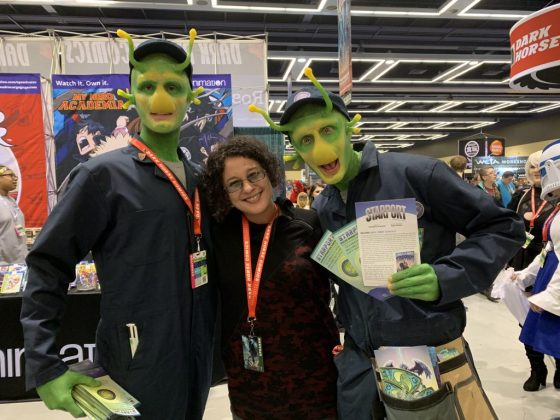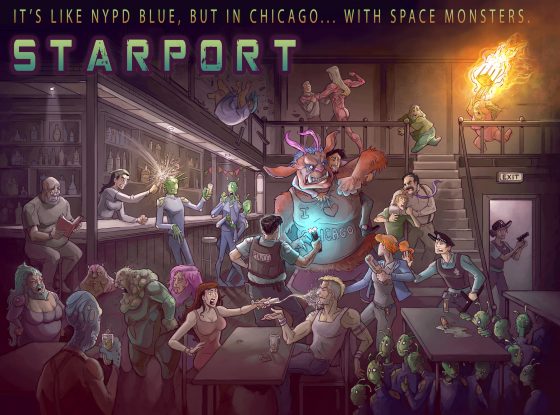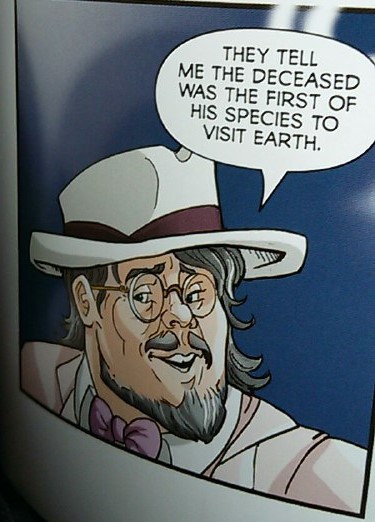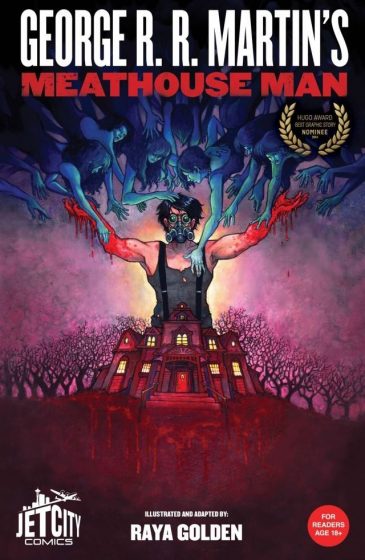Last March, a script from George R. R. Martin for a TV show written in the ’90s finally saw the light of the day: Starport became a graphic novel, by the hands of the artist Raya Golden, and it’s with her we’ll be speaking this time. Raya was born in New York and graduated at the Academy of Art University in San Francisco, California. She’s been work as Martin’s assistant for the last 9 years, concentrating the functions of Art, Web and Licensing manager in the Fevre River Packet Co. As an artist, her first graphic novel was an adaptation of Meathouse Man, which was nominated for the Hugo Awards.
We had already talked to Raya when she kindly helped us to get authorization to translate Martin’s speech The Heart of a Small Boy (which you can read here in English and our version here) into Portuguese. This time, our interaction was equally pleasant: she is a very kind and funny person and amazingly professional.
If you’re not familiar with the graphic novel, you can always check our review of Starport (in Portuguese, but Google Translate can work wonders). And if you’d like to read something already written in English, we recommend the always precise Adam Whitehead with his review on the Wertzone.
♛ Clique aqui para versão em português da entrevista.

Arthur Maia: How did you get to adapt Starport? Was it George’s idea or yours? Why was this specific story chosen?
Raya Golden: Starport was one of George’s final pilots in the 90’s and he suggested I give it a try while beginning a number of graphic novel adaptation deals with Random House Publishing. He chose it for me based on my style, saying he felt I could lend to the story and I wasn’t going to disagree with him. I am hoping to do more projects and this felt like this was a great place to try and begin my career in graphic novels.
Arthur Maia: As typical Martin, Starport is really meaningful on the “human heart in conflict with itself”. In some ways, it seems to me that the themes it touches are even more in the order of the day in 2019 than in the mid-’90s. How do you see that and what main messages were you concerned to convey when adapting it?
Raya Golden: Many of the underlying themes were relevant on their own in a completely different way than what GRRM may have intended which was strangely awesome. For example, I added a little more focus to a set of interactions between partners Rutledge and Manning where Rutledge, a woman, walks into the men’s room in concern for Manning’s state of mind and he tells her it’s the men’s bathroom and she should take a hike. She retorts with something along the lines of “it’s just a room stop being a big baby about it” then enters anyway to emotionally support her partner and friend. This is a very different message in the 90’s than it is today, and I wanted to put some emphasis on this as well as other differences in a relevant and accessible way. There were a number of themes that could be taken the wrong way in today’s world, but I strove to adjust each of these from a more present and sensitive angle while remaining true to the original context.
Arthur Maia: You said you received two drafts to work with. Were they “the earthquake” draft (139 pages) and the first official draft (118 pages) Martin mentions in Quartet? How did you conciliate the two versions? Were there any scenes or characters that you struggled to decide if you should include or not?

Raya Golden: Yes, there were two versions, a longer one and the first 118-page draft. I translated the two versions by sitting them side by side and drawing out the entire comic in thumbnail format. The first half of these two versions are virtually identical so that part was easy, the hard part came later resolving the two Spiderhound story arcs and simply choosing the most visually compatible versions of either script. I also really wanted to include the character STAKKO NIHI whom is quite fun and was in part the reason I wanted to take on the script. George kept saying his catch line to me “WHO LOVES THE INFANTS” and it took me a long while to get it being such and old school TV reference but when I got it I couldn’t stop laughing. The version without Stakko is a more “hard boiled” and serious version, whereas the Stakko version adds a portion of levity I wanted to really draw back out in the graphic novel adaptation. I felt going for a neon retro feeling and playing off of the more fun aspects would better fit my style of art as well as keeping the older themes a little easier to approach.
Arthur Maia: As a reader, I admit I was amazed at the concept of the Harmony and it’s 315 species. How was the creative process for their appearance? Do you have a favorite one?
Raya Golden: I pretty much followed the script, I’m kinda sure we only have three main species because a 90’s TV show could only afford to produce that many for a pilot episode. But I strove to populate Starport Chicago with not only the three main species on planet Earth Lohb, Nhar, and Chaseen, but with plenty of random tourist species that may or may not become more important in a sequel. Since it’s a drawing and not a TV production I kind of wanted to push what I could do with these characters that would stretch the limits of what could be produced on a show. My favorite will always be Stakko, I always imagen him as The Rock playing Bambi as a Minotaur; dressed to audition for a live action He-Man movie. He’s fun, friendly, cheesy and gigantic and he melts my heart every time.

Arthur Maia: I couldn’t help to notice Dr. Bonfleur’s appearance, as he resembles a lot the late and amazing Gardner Dozois. How that homage came to be?
Raya Golden: Yes, and I’m so happy you caught it. I’ve known Gardner pretty much all my life, he was a dear friend of the family and Dr. Bonfleur just reminded me of him. So I made him look like Gardner just because, that was all me. And I was planning on surprising him with it, but unfortunately, he passed before I got the chance.
Arthur Maia: You have once adapted Meathouse Man. It’s very different from Starport – darker, shorter more intimist and violent. How did you feel the differences between those two processes?
Raya Golden: The Meathouse Man I did all by myself with no other help, it was a shorter amount of time but still almost 9 months to complete just 36 pages. So, I hired a colorist, Rachel Hilley, for Starport as well as making the commitment to purchase a Cintiq and moving my inking process to strictly digital. In the end my process was more refined, but it was the same process with very different scripts. The Meathouse Man was a seriously dark story, and there was no other way to go about it, and I felt Starport was best represented in a bit more retro, fun and light hearted as well as making it more accessible to wider audience.

Arthur Maia: As Starport was conceived as a TV show, a sequence to that initial story would be very welcome, exploring the other species, more backstory to both the cops and the aliens and many other mysteries to come. Is that a possibility, even with no scripts written so far?
Raya Golden: I am totally hoping to enlist a new writer to script a Starport part two as I don’t feel confident writing a script myself from scratch. but I am into working with a professional to flesh out a few more editions of Starport, possibly exploring all of the themes you mentioned and more!
Arthur Maia: And what’s next for Raya Golden? Do you plan to publish some original material? And what about some more adaptations?
Raya Golden: I really want to do a follow up to Starport, but ideally would love to try a change of pace for my next project. I’m shopping around a few proposals along these lines which include both new material based on some of my wish list concepts as well as another possible adaptation by a different author. And naturally I’d be happy to be approached by a team to work as their pencil/inker on a completely different project that’s just as fun as what I’ve been lucky enough to work on so far.
Check out Raya’s process to Starport in video:
Starport is available on Amazon in ebook version and hardcover.
